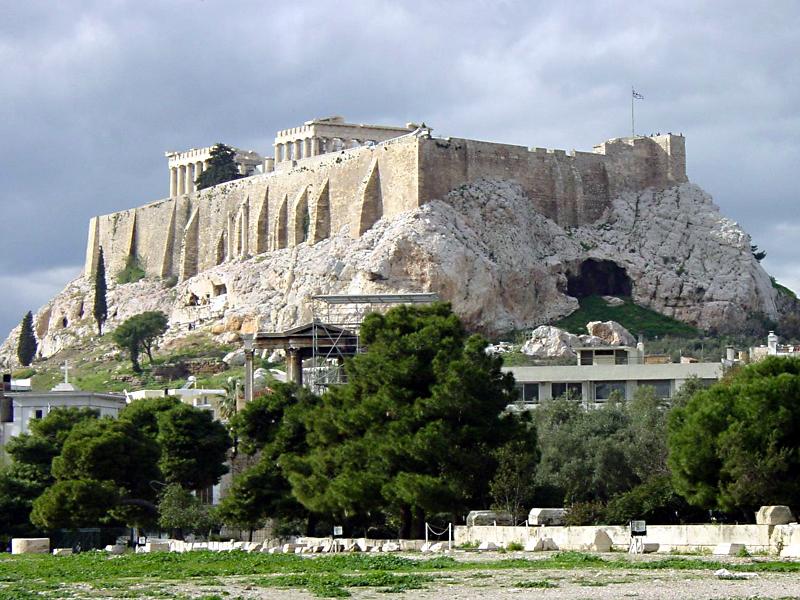
THE ACROPOLIS OF ATHENS.
MANY walled cities of the East, especially those of historic fame, had within their enclosure some hill or rocky elevation, which was doubly fortified, and into which the citizens withdrew in time of war when the outer walls had failed to keep out the enemy. In these citadels were usually placed the shrine of the patron god of the city, and various other buildings of art. Such an enclosure was known by different names in different countries. They were most common, however, among the Grecians, who gave it the name of Acropolis, a word, which meant in their language "the highest part of the city."
The people of ancient Athens gave themselves up almost entirely to art, religion and philosophy; and they made their Acropolis so resplendent with temples, statues, and shrines, that it far excelled that of any other city, and was called by way of preeminence "The Acropolis." The accompanying cut gives but a faint idea of the magnificence and grandeur displayed upon that huge rock; for the Acropolis at Athens was nothing else than a huge rock, rising five hundred feet above the plain and over one thousand feet above the sea. The top was flat, and one thousand feet long by five hundred broad. Three of its sides were almost perpendicular by nature, and when they were carried still higher by massive walls, the place was absolutely unapproachable, except at one end, where the ground sloped quite steeply down to the city below. Here the only entrances were through long winding passages left in the ponderous wall. A winding stair leading to one of these passages can be seen in the front of the picture. Imagining ourselves just inside this entrance, in the old days of the city's glory, we stand in a large court surrounded by a high wall, and containing several temples and arches built of different colored marble, while in front of us are flights of stairs leading up to the grand entrance to the Acropolis proper. Mounting these stairs and passing through this magnificent portal, we are for a moment blinded by the dazzling scene that meets our view.
Directly in front of us, on a pedestal twenty feet high, towers the brazen form of the goddess Minerva, holding aloft her shield and spear, and her head crowned with a helmet of war. Minerva was thought by the Athenians to be their guardian goddess, and hence they called their city by her name, for the Greek word for Minerva is Athens.
So this image was put up where it could be seen from all parts of the city and surrounding country, and even from far out on the sea, which was several miles away. The superstitious people were foolish enough to think that as long as this huge brazen form remained, their city could not perish.
To the right, we view the world-renowned Parthenon, or temple of Minerva. Though there exist many other structures of greater size, none are so noted for architectural beauty, symmetry of form, and rare sculpture, as this heathen temple.
It was built entirely of white marble. On the inside of the walls were scenes cut in the marble, which the most skillful sculptors the world ever produced were years in executing. At one end of the temple stood another figure of Minerva thirty-nine feet in height, and made of solid ivory, covered with gold. The gold that covered this image was alone worth over a million dollars.
Scattered over the remainder of the surface of the Acropolis, and built in the walls, were many other small temples and shrines, each a wonder in itself, glittering with gold and peopled with statuary; and in the open courts between, were scores of marble figures representing heathen gods, illustrious generals and philosophers, in all kinds of attitudes, making the place look as though it were inhabited by a race of giants, whose dwellings were the temples around them. But all these works of art have long since perished or have been carried away by conquering nations, and today it is with difficulty that even the location of the walls can be determined with accuracy.
Before the city had fallen into decay, however, the great apostle Paul visited it, and the Bible says his spirit was stirred within him when he saw the city so full of idols. This good man tried to show the people that though they had so many gods, yet there was one they did not know, and that He was the only true God, and did not dwell in their temples, nor did he need help from them; that he it was who made the heavens and the earth, and the people in it, and so they ought not to think he was like gold and brass and stone graven by their hands. Many of the people listened to Paul's words, among them the wisest philosophers of the city. But they were so wrapt up in their grand buildings and idols that only two are recorded as having believed him and turned from their idolatry to the worship of the true God.
But "the truth of God standeth fast," while the vain philosophy of the Athenians and their works of art have come to naught. Acts 17 gives a full account of Paul's visit to Athens and the speech he made before its wise men.
C. H. G.